
Now that we're done with these polygons, we right click and select "Convert to Editable Poly" (Or Editable Mesh to those who prefer that)ĭo the same for the interior walls and the trim. And to keep the textures proportional, we need to set all three sizes to the same (in this case it's the height of this part of the mesh). Since this part of the mesh is a box we'll use a box modifier. You go to Modifier>UV Coordinates>UVW Map. It still look horrible, doesn't it? We need to set the polygon's UVW coordinates.

Type the number of the texture you want to apply to these faces (in this case 1). Scroll down and you'll see a grid with numbers in each of them and above that "Set ID" with a text input box next to it. Now what we need to do is go back into Editable Poly/Editable Mesh (depending on how you modeled the building) and go to Polygon/Face and select all the exterior wall faces. I'd suggest writing down the ID numbers and their corresponding textures before continuing. What we need to do is change the material IDs for the polygons to match the ID number of the texture we want to use. The numbers to the left of the slots is the ID number for that particular texture. That's because we haven't adjusted it's Material IDs. Then once you have the necessary slots filled, select the building and click "Assign Material To Selection" Now click go to parent again to go to the main material (the one with the 10/2 slots) and repeat the process so that you have textures for the exterior walls, interior walls, cieling, floor, trim, and roof. Click that and from the popup select "Bitmap" Then select your texture.Īnd then click "Show map in Viewport" and name it something descriptive like "Exterior Wall" Further right for Diffuse is a gray square. To the right of those are two boxes with a color swatch in them. Under (Shader name) Basic Parameters you'll see Ambient and Diffuse. First we'll add in an exterior wall texture. You can add more but I have had serious issues doing so, as you could see when I first imported the Visitor Center into JPO. Now that you have this set you'll see either 2 or 10 empty texture slots (depending on if it's gMax or 3ds Max). I don't know if gMax has is but in 3ds Max I recommend you change the shader to Phong, this is the shader used by the original Trespasser Developers as well as the TC Ops in TC~Isle In 3ds Max you open the Material Editor and click an empty sphere and select the "Standard" button and choose "Multi/Subobject" from the list that pops up. We want "Multi/Sub Object" or similar (forgive me but I forget some of the details for gMax such as the exact wording). In gMax you open the Material Editor and click New. (this is not copy!)(in perspective viewport) create target camera using the curent view.The material editors in both programs are different in how you start a new material but they function the same.


Polygon Count (displayed at upper left of viewport for selected object).

Select hidden objects in select from scene dialog by name to unhide those objects.Ĭenter active viewport to the mouse's position.Īdaptive degradation, shows objects as boxes, speed up viewport drawing in complex scenesĬhange active viewport to "Perspective" view. Rotate selected object (does not Select). If you have more than 1 camera in your scene, this will toggle between cameras.ĭisable view (prevents view from updating used when editing very large scenes to improve performance) 3DS Max is not case insensitiveĬhange active viewport to "Camera" view (there must be at least 1 camera in your scene for this command to work). A does not toggle Angle Snap but a does.īe aware this chart is unaccurate in that respect. Description (all these letters should be lowercase) e.g.


 0 kommentar(er)
0 kommentar(er)
